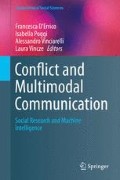Abstract
The detection of conflict cues in call center interactions may be related to the quality assessment of the services provided, since these cues reveal both speakers’ emotional states and positioning as expressed through complaining and identifying problematic issues on the one hand and managing requests or resolving problems on the other hand. This paper describes a set of emotional and conversational cues associated to conflict as well as a machine learning approach to classify emotional speech units occurring in a call center dataset by employing emotion labels as well as automatically extracted acoustic and additional context-related features.
Access this chapter
Tax calculation will be finalised at checkout
Purchases are for personal use only
References
Allwood J (2007) Cooperation, competition, conflict and communication. Gothenbg Pap Theor Linguist 94:1–14
Allwood J, Cerrato L, Jokinen K, Navarretta C, Paggio P (2007) The MUMIN coding scheme for the annotation of feedback, turn management and sequencing phenomena. Multimodal corpora for modeling human multimodal behaviour. J Lang Resour Eval 41(3–4):273–287
Burkhardt F, Polzehl T, Stegmann J, Metze F, Huber R (2009) Detecting real life anger. In: ICASSP 2009, Taipei, Taiwan, 19–24 Apr
Chang CC, Lin CJ (2011) LIBSVM: a library for support vector machines. ACM Trans Intell Syst Technol 2(3). http://www.csie.ntu.edu.tw/∼cjlin/libsvm
Erden M, Arslan LM (2011) Automatic detection of anger in human-human call center dialogs. In: Interspeech 2011, Florence, Italy, 28–31 Aug
Esposito A, Riviello MT (2011) The cross-modal and cross-cultural processing of affective information. In: Apolloni B et al (eds) Proceedings of the 2011 Conference on Neural Nets WIRN10: Proceedings of the 20th Italian Workshop on Neural Nets. IOS Press Amsterdam, The Netherlands, pp 301–310
Eyben F, Wollmer M, Schuller B (2010) openSMILE—the Munich versatile and fast open-source audio feature extractor. In: ACM multimedia, Florence, Italy, pp 1459–1462
Grezes F, Richards J, Rosenber A (2013) Let me finish: automatic conflict detection using speaker overlap. In: Interspeech 2013, ISCA, Lyon, France
Hall M, Frank E, Holmes G, Pfahringer B, Reutemann P, Witten IH (2009) The WEKA data mining software: an update. SIGKDD Explor 11:10–18
Jahromi AT, Sepehri MM, Teimourpour B, Choobdar S (2010) Modeling customer churn in a non-contractual setting: the case of telecommunications service providers. J Strateg Mark 18(7):587–598
Kim S, Filippone M, Valente F, Vinciarelli A (2012) Predicting the conflict level in television political debates: an approach based on crowdsourcing, nonverbal communication and Gaussian processes. In: ACM international conference on multimedia, Nara, Japan, pp 793–796
Lee CM, Narayanan S (2005) Toward detecting emotions in spoken dialogs. IEEE Trans Speech Audio Process 13(2):293–303
Morrison D, Wang R, De Silva LC (2007) Ensemble methods for spoken emotion recognition in call-centres. Speech Comm 49(2):98–112
Mower E, Mataric MJ, Narayanan S (2011) A framework for automatic human emotion classification using emotion profiles. IEEE Trans Audio Speech Lang Process 19(5):1057–1070
Narayanan S, Gregoriou P (2013) Behavioral signal processing: deriving human behavioral informatics from speech and language. Proc IEEE 101(5):1203–1233
Neiberg D, Elenius K (2008) Automatic recognition of anger in spontaneous speech. In: Interspeech 2008, Brisbane, Australia, 22–26 Sept, pp 2755–2758
Pesarin A, Cristani M, Murino V, Vinciarelli A (2012) Conversation analysis at work: detection of conflict in competitive discussions through semi-automatic turn-organization analysis. Cogn Process 13(Suppl 2):533–540
Polzehl T, Schmitt A, Metze F, Wagner M (2011) Anger recognition in speech using acoustic and linguistic cues. Speech Comm 53(9–10):1198–1209, Special Issue on Sensing Emotion and Affect—Facing Realism in Speech Processing
Riviello MT, Chetouani M, Cohen D, Esposito A (2011) Inferring emotional information from vocal and visual cues: a cross-cultural comparison. In: IEEE 2nd international conference on cognitive computation, Budapest, pp 1–4
Sacks H, Schegloff E, Jefferson G (1974) A simplest systematics for the organization of turn-taking in conversation. Language 50:696–735
Schegloff E (2000) Overlapping talk and the organisation of turn-taking for conversation. Lang Soc 29(1):1–63
Schröder M (ed) (2013) Emotion markup language (EmotionML) 1.0, W3C Proposed Recommendation 16 Apr 2013. http://www.w3.org/TR/emotionml/
Schröder M, Pelachaud C (ed) (2012) W3C vocabularies for EmotionML, W3C Working Group Note 10 May 2012. http://www.w3.org/TR/emotion-voc/
Schuller B et al (2007) The relevance of feature type for the automatic classification of emotional user states: low level descriptors and functionals. In: Interspeech 2007, Antwerp, pp 2253–2256
Schuller B et al (2010) The INTERSPEECH 2010 paralinguistic challenge—age, gender, and affect. In: Proceedings of 11th international conference on spoken language processing, interspeech 2010—ICSLP, Makuhari, Japan, 26–30 Sept, pp 2794–2797
Schuller B, Batliner A, Steidl S, Seppi D (2011) Recognising realistic emotions and affect in speech: state of the art and lessons learnt from the first challenge. Speech Comm 53(9/10):1062–1087, Special Issue on Sensing Emotion and Affect—Facing Realism in Speech Processing
Schuller B, Steidl S, Batliner A, Vinciarelli A, Scherer K, Ringeval F, Chetouani M, Weninger F, Eyben F, Marchi E, Salamin E, Polychroniou A, Valente F, Kim S (2013) The interspeech 2013 computational paralinguistics challenge: social signals, conflict, emotion, autism. In: Interspeech 2013, ISCA, Lyon, France
Vidrascu L, Devillers L (2007) Five emotion classes detection in real-world call center data: the use of various types of paralinguistic features. In: International workshop on Paralinguistic Speech—between models and data, ParaLing, pp 11–16
Acknowledgments
The research leading to these results has been partially funded by POLYTROPON project (KRIPIS-GSRT, MIS: 448306). Also, the participation to Dagstuhl Seminar 13451 “Computational Audio Analysis” held from Nov 3 to 8, 2013, in Wadern, Germany, inspired Anna Esposito to contribute to this work.
Author information
Authors and Affiliations
Corresponding author
Editor information
Editors and Affiliations
Rights and permissions
Copyright information
© 2015 Springer International Publishing Switzerland
About this chapter
Cite this chapter
Koutsombogera, M. et al. (2015). Conflict Cues in Call Center Interactions. In: D'Errico, F., Poggi, I., Vinciarelli, A., Vincze, L. (eds) Conflict and Multimodal Communication. Computational Social Sciences. Springer, Cham. https://doi.org/10.1007/978-3-319-14081-0_20
Download citation
DOI: https://doi.org/10.1007/978-3-319-14081-0_20
Published:
Publisher Name: Springer, Cham
Print ISBN: 978-3-319-14080-3
Online ISBN: 978-3-319-14081-0
eBook Packages: Computer ScienceComputer Science (R0)

